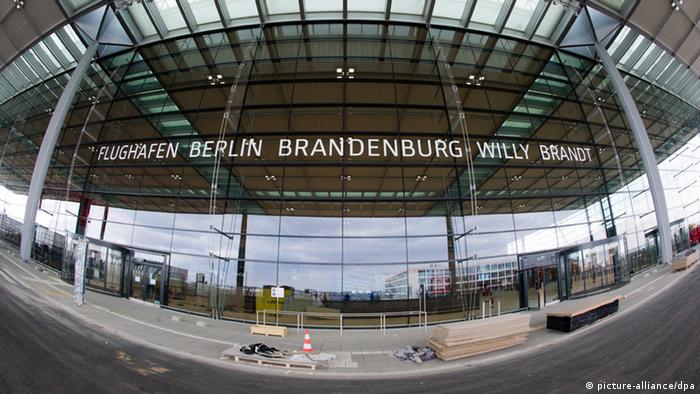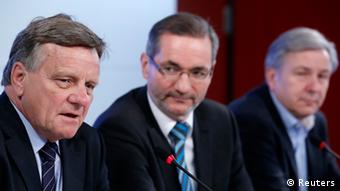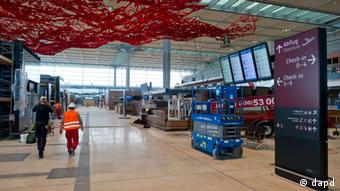Αν και η Γερμανία έχει κατηγορήσει πολλές
φορές την Ελλάδα για κατασπατάληση δημοσίου χρήματος, διαφθορά, κακοδιαχείριση του δημόσιου τομέα και άλλα πολλά, έχει κι εκείνη το δικό της «γεφύρι της Άρτας» που δεν είναι άλλο από το νέο αεροδρόμιο του Βερολίνου.
Πρόκειται για ένα από τα μεγαλύτερα δημόσια έργα που βρίσκεται σε εξέλιξη στην οργανωμένη οικονομική πρωτεύουσα της Ευρώπης, το οποίο θα έπρεπε να έχει παραδοθεί από το 2010, όμως πέντε χρόνια μετά συνεχίζει να κοστίζει 16 εκατ. ευρώ μηνιαίως στους Γερμανούς φορολογούμενους!
Το έργο είχε αρχικά κοστολογηθεί στα 6,8 δις ευρώ, ποσό που αν υπολογίσει κανείς πόσο κάνει 5 χρόνια επί 12 μήνες επί 16 εκατ. ευρώ, έχει υπερβεί το ποσό ήδη κατά περίπου 960 εκατ. ευρώ.
Ο γολγοθάς της καθυστέρησης της παράδοσης του έργου ξεκίνησε όταν κυκλοφόρησε το νέο Airbus A380 και ελήφθη η απόφαση το αεροδρόμιο να επεκταθεί από τα 200.000 στις 350.000 τετραγωνικά μέτρα. Οι εργασίες κατανεμήθηκαν σε 7 κατασκευαστές και εκατοντάδες υπεργολάβους.
Ένας νέος κύκλος επανασχεδιασμού ξεκίνησε με μηχανικούς και αρχιτέκτονες να βγάζουν τα μολύβια και να σχεδιάζουν τοίχους, εξόδους, φώτα κινδύνου, συστήματα εξαερισμού, παράθυρα, ανελκυστήρες και σκάλες.
Η Siemens και η Bosch δεν θα μπορούσαν να λείπουν βέβαια από το κολοσσιαίο έργο. Ήταν οι μηχανικοί των εταιριών αυτών που επέστησαν την προσοχή στις αδυναμίες του συστήματος πυρασφάλειας. Ο τρόπος για να λυθεί το πρόβλημα ήταν μία πρόταση ενός συστήματος που περιελάμβανε 3.000 πόρτες πυρασφάλειας, 65.000 εκτοξευτές αφρού, χιλιάδες ανιχνευτές καπνού, έναν λαβύρινθο από κανάλια για τη διοχέτευση του καπνού και περίπου 100 χλμ καλώδια. Η πρόταση ωστόσο φάνηκε υπερ-φιλόδοξη και οι αστοχίες επέφεραν την πρώτη καθυστέρηση.
Μετά από ένα κύμα αλληλοκατηγοριών μεταξύ Bosch και Siemens, ο διευθύνων σύμβουλος της κοινοπραξίας που κατασκεύαζε το έργο προσπάθησε να υποβαθμίσει την επικινδυνότητα των εγκαταστάσεων και πρότεινε μία «ευφάνταστη λύση», έτσι ώστε το αεροδρόμιο να παραδοθεί εντός της προθεσμίας.
Ήταν Μάρτιος του 2012, όταν η κοινοπραξία πρότεινε 800 χαμηλόμισθοι εργαζόμενοι να βρίσκονταν σε μόνιμη βάση σε κομβικά σημεία του αεροδρομίου, και αν τυχόν κάποιος μύριζε φωτιά να ειδοποιήσει την πυροσβεστική. Η Άνγκελα Μέρκελ «άνοιξε» το αεροδρόμιο κόβοντας την κορδέλα σε μία λαμπερή τελετή, ωστόσο μετά την τελετή η Πυροσβεστική το «έκλεισε» αρνούμενη να δώσει άδεια λειτουργίας για λόγους επικινδυνότητας.
Η παράδοση του αεροδρομίου συνέχισε να υπερβαίνει το ένα χρονικό όριο μετά το άλλο, και πλέον υπολογίζεται ότι δεν πρόκειται να ανοίξει πριν το 2018 – 2019. Το κόστος στο μεταξύ μεγαλώνει…
Κι όσο η Γερμανία συνεχίζει να κουνάει το δάχτυλο σαν δασκάλα της λιτότητας στην Ελλάδα, ακόμη και μετά τη επώδυνη συμφωνία των Βρυξελλών, δεν είναι άδικο να σκεφτεί κανείς την ελληνική παροιμία.. «δάσκαλε που δίδασκες και λόγο δεν εκράτεις».
http://tvxs.gr
ΚΑΙ ΓΙΑ ΟΣΟΥΣ ΠΑΡΑΜΕΝΟΥΝ ΔΥΣΠΙΣΤΟΙ :
Berlin Airport: The five biggest mistakes
1. Amateurs at work
It recently emerged that Alfredo di Mauro, chief planner for BER's fire protection system, is not a qualified engineer but a technical draftsman. He has now confirmed this himself: "Everyone thought I was an engineer," he told the dpa news agency. "I just didn't contradict them." At the beginning of May, BER chief Hartmut Mehdorn cut his losses and fired di Mauro.
Meanwhile, technical chief Horst Amann, hired in August 2012 as project savior, was apparently not the right choice after all. His colleagues considered him completely out of his depth, and he too lost his job. His successor, chief planner Regina Töpfer, was let go in February 2014.
Critics see the main cause of the BER disaster in the fact that inspectors and those responsible all collectively failed. For some time, the board of directors was run not by specialists, but by two politicians: Berlin Mayor Klaus Wowereit and Brandenburg State Premier Matthias Platzeck.
2. Faulty fire protection
The biggest obstacle to BER's opening is the faulty fire protection system, a problem that has been known about since May 2012. The ventilation system still does not work, and its flaw is fairly basic: Unlike in other major projects, the architects had planned to funnel smoke - which usually rises - underneath the airport's halls. This piece of technical insanity now has to be completely redesigned and rebuilt. Companies Bosch and Siemens are working on this.
3. Corruption suspicions
The airport's former technical director Jochen Grossmann is facing corruption charges. He is accused of having accepted around half a million euros ($680,000) in bribes. On top of that, he is being investigated for price fixing. BER sources say that further revelations of wrongdoing cannot be ruled out.
4. Bad planning
Apart from the flawed fire protection system, other major problems and mistakes have now been discovered. The cable shafts are dangerously over-burdened, and there aren't enough check-in counters and luggage retrieval systems. The cooling units are too weak, creating the threat of overheating and emergency cut-offs to the entire IT system, which would leave Berlin's new airport without computers. On top of all that, flight paths and sound protections zones were incorrectly calculated.
BER airport has been planned for a capacity of 27 million passengers a year, but experts say that won't be enough in the long run. In other words, as soon as the airport opens it will have to be extended.
5. Cost explosion
Before construction began in 2006, the costs were set at 2.5 billion euros. But Martin Delius, member of the Pirate Party and chairman of the Berlin's parliament's BER investigation committee, says that no one knows what the final cost of the airport will be. "At the moment we're up to 4.7 billion euros, but that's without the parking facilities and the transport connections," he said. "Altogether we're already well over six billion, and that certainly won't be the end." Unofficially, people are already mooting total costs of eight billion.
And there are other problems looming: according to media reports, the EU Commission is now investigating whether subsidies of 30 million euros will have to be paid back. Not only this, but airline Air Berlin is already demanding 48 million euros in damages caused by the multiple postponements. To add salt to the wound: current BER chief Hartmut Mehdorn filed the lawsuit himself in November 2012, when he was Air Berlin's CEO.
Conclusion: The opening is a long way off
Berlin's new airport should have opened in October 2011. The opening has been postponed a number of times, and at the moment there is no new opening date for when the airport can take up operations. The head of the German parliament's transportation committee, Social Democrat Martin Burkert, said on May 14 this year that an opening is unlikely before 2017.
It's no wonder, then, that news magazine Der Spiegel has called for a new beginning, at a new location and with new people in charge: "Maybe at the end of the day, the radical solution would be the best: Convert the airport into a monument to provincial hubris."


































0 Σχόλια:
Δημοσίευση σχολίου
Σχόλια και παρατηρήσεις